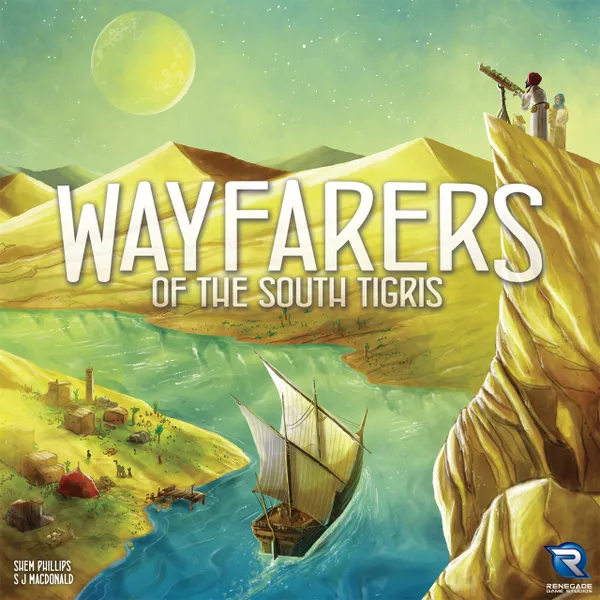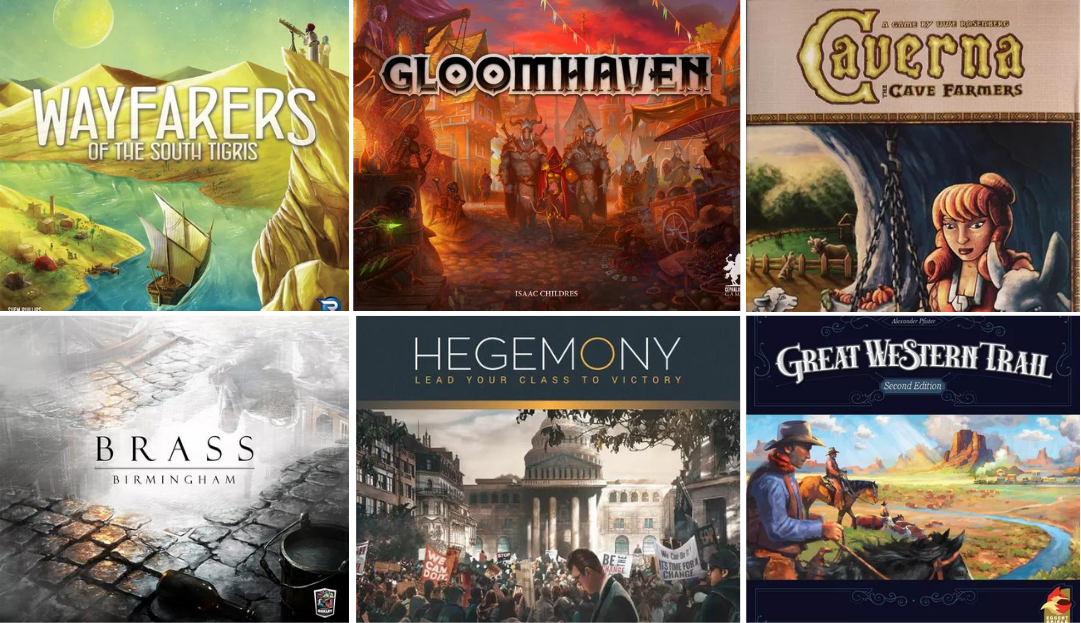Welcome to this week’s gaming post! This is the conclusion to my three-part series where I talked about my favorite Gateway games, Gateway + games (effectively medium-weight games), and now for this week I’ll be discussing my favorite heavy games. Everyone has a slightly different definition of what a heavy game entails (no these are not the games with the heaviest boxes), so I’ll preface that while these games range in terms of complexity, they are all at least in the upper threes according to BGG’s weight rating. So without further ado, let’s jump into the games.
Honorable Mention: Wayfarers of the South Tigris
- Designers: S J Macdonald, Shem Phillips
- Publisher: Garphill Games
- Complexity: Heavy
- Time: 60-90 Minutes
- Players: 1-4
- Main Mechanisms: Dice/Worker-Placement

First up is a relatively new game to my collection: Wayfarers of the South Tigris, the first game in Garphill Games’ South Tigris series. In this game, players place dice and workers on action spaces, while collecting a tableau of land, sea, and space cards that unlock new worker placement spots, offer bonuses, and score points at the end of the game. I’ve posted about some of my thoughts on the game here, but I really love how many options you have in this game, as well the mechanism for upgrading your dice to give more icons/abilities. The game also looks more complex than it actually is, as most of the dice/worker placement spots are slight variations of each other. If you’re a fan of Garphill Games and/or tableau building with dice placement/manipulation then I definitely recommend giving this one a play.
5. Brass: Birmingham
- Designers: Gavan Brown, Matt Tolman, Martin Wallace
- Publisher: Roxley
- Complexity: Heavy
- Time: 60-120 Minutes
- Players: 2-4
- Main Mechanisms: Network/Route Building, Hand Management

While Brass: Birmingham has a fairly high complexity rating on BGG, it actually doesn’t feel that heavy to me. On your turn, you either play a card of the appropriate type to build an industry or discard a card to take one of the other five actions (building rail, selling goods, taking a loan, etc.). It could be that I’ve played Brass: Birmingham so many times that some of the more complex rules around how you can use the resources (coal, iron, and beer), as well as where you can build feel like second nature at this point. I tend to really enjoy complex economic games that allow you to build up a network, and Brass: Birmingham is no exception. And even though the game is set during the Industrial Revolution, the artwork is very nice. If you haven’t had the chance to try Brass: Birmingham, the fact that it’s currently the number one ranked board game on BGG should be reason enough to give it a shot.
4. Great Western Trail
- Designer: Alexander Pfister
- Publisher: Eggertspiele
- Complexity: Heavy
- Time: 75-150 Minutes
- Players: 1-4
- Main Mechanisms: Rondel, Deckbuilding

I’ve talked about how much I love Great Western Trail in the past, and now I can proudly say that I own the original, Argentina edition, and New Zealand edition. In all of the Great Western games, you move along a rondel, stopping to take actions, before eventually delivering your cattle (or sheep) to receive money and score victory points. And once you’ve delivered, you go back to the beginning of the rondel to do it all again. I love the deck-building, slight push-your-luck mechanisms, and how each version of the game has a slightly different take on the proven formula. I also like how the rondel will evolve over the course of the game as each player builds new buildings that unlock more action spaces. Argentina added a new type of worker and more things to consider when delivering cattle, while New Zealand feels the most different with new deckbuilding cards, a pathfinder track, and a boat that replaced the train. If I were to recommend one to jump into first, it would be either the first or second edition of the original game to find out if you like the core formula, before checking out Argentina and New Zealand.
3. Hegemony: Lead Your Class to Victory
- Designers: Vangelis Bagiartakis, Varnavas Timotheou
- Publisher: Hegemonic Project Games
- Complexity: Heavy
- Time: 90-180 Minutes
- Players: 2-4
- Main Mechanisms: Hand Management

The next game on the list feels like it was designed for my preferred taste in games. Hegemony: Lead Your Class to Victory is a heavy, asymmetric political and economic game where each player takes on a role as either the Working Class, Middle Class, Capitalists, or the State. I can’t think of another game where the mechanisms are so tightly woven into its theme. And even though the game is certainly very complex, the theme makes it easier to grasp the rules. There’s also tons of player interaction as each of the different classes will need to work with the other players to accomplish their goals. Last year, it felt like this game came out of nowhere, and of the games that were released during last year, not counting Dune: Imperium – Uprising, which is a sequel of sorts to Dune: Imperium, Hegemony is the highest ranked game on BGG. Of the games on this list, Hegemony is by far the most complex, but if you have a group of four and are able to overcome the initial learning period, the game is brilliant, and I can’t recommend it highly enough.
2. Caverna: The Cave Farmers
- Designer: Uwe Rosenberg
- Publisher: Lookout Games
- Complexity: Heavy
- Time: 30-210 Minutes
- Players: 1-7
- Main Mechanisms: Worker Placement

Next on the list is my favorite Uwe Rosenberg sandbox game – Caverna: The Cave Farmers. In Caverna, players take on a family of dwarfs, competing with other players to build the best furnished cave and farm of crops and animals. I’ve already discussed a few of the things I love about Caverna here, and typically I’m not as big of fan of games that throw a ton of options at players at the beginning of the game (cough, cough, Feast of Odin). However, I think the fact that the worker placement spots grow over the course of the game help to manage that feeling in Caverna. Therefore, I am able to truly appreciate the amount of variety there is in the game. One game, I might decide to hole up in the mountains, focusing on mining and building elaborate rooms, and another I might instead go all-in on raising sheep. Due to the variety of rooms available, both of these strategies are viable and incredibly satisfying to pull off. For me, Caverna perfectly scratches the heavy sandbox itch.
1. Gloomhaven
- Designer: Isaac Childres
- Publisher: Cephalofair Games
- Complexity: Heavy
- Time: 60-120 Minutes
- Players: 1-4
- Main Mechanisms: Hand Management

Although I typically prefer to play Gloomhaven digitally these days, it is still my favorite heavy game, and not to mention, one of my all-time favorites. Gloomhaven is a cooperative dungeon-crawler where players take on the role of a character who each has a unique deck of cards. Player turns are actually relatively straightforward. Before each round, players select two cards from their hand of cards to activate that round. When it’s a player’s turn, they use the top action on one of the cards and the bottom action on the other. One of the most interesting mechanisms is that over the course of a scenario, players will lose cards from their deck which shrinks the number of cards they have available to use. In addition to your character losing all of their hit points, if you run out of cards, your player is also out of the scenario. I haven’t even talked about all of the legacy elements of this game. Between scenarios, players will unlock more cards to add to their decks and will be forced to make choices that will impact the party and future scenarios. Some of my favorite memories playing board games are from Gloomhaven, and I can’t recommend it highly enough as my favorite heavy board game.
With that, I’ll wrap up this week’s gaming highlights! I’d love to hear your thoughts on any of the games I’ve mentioned, future content, or format in the comments section below, and let me know what your favorite heavy games are. Happy gaming!
If you liked this post and want to be notified when new content is released, then follow me on Instagram @themeepledigest.
